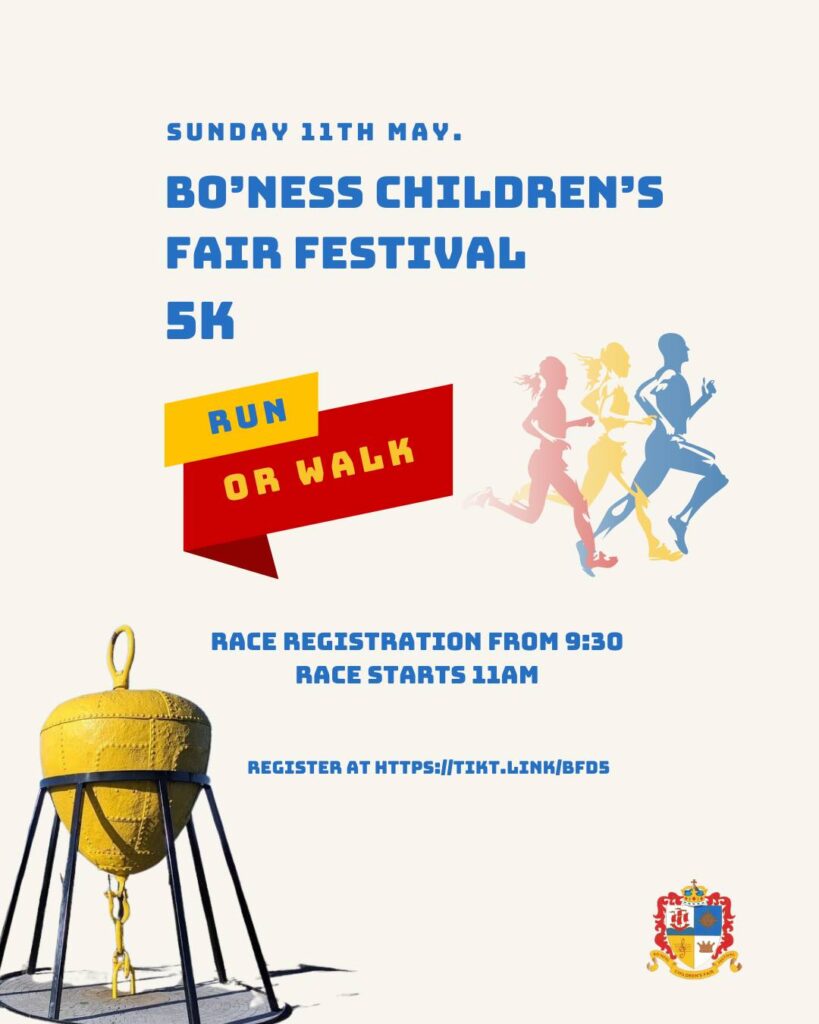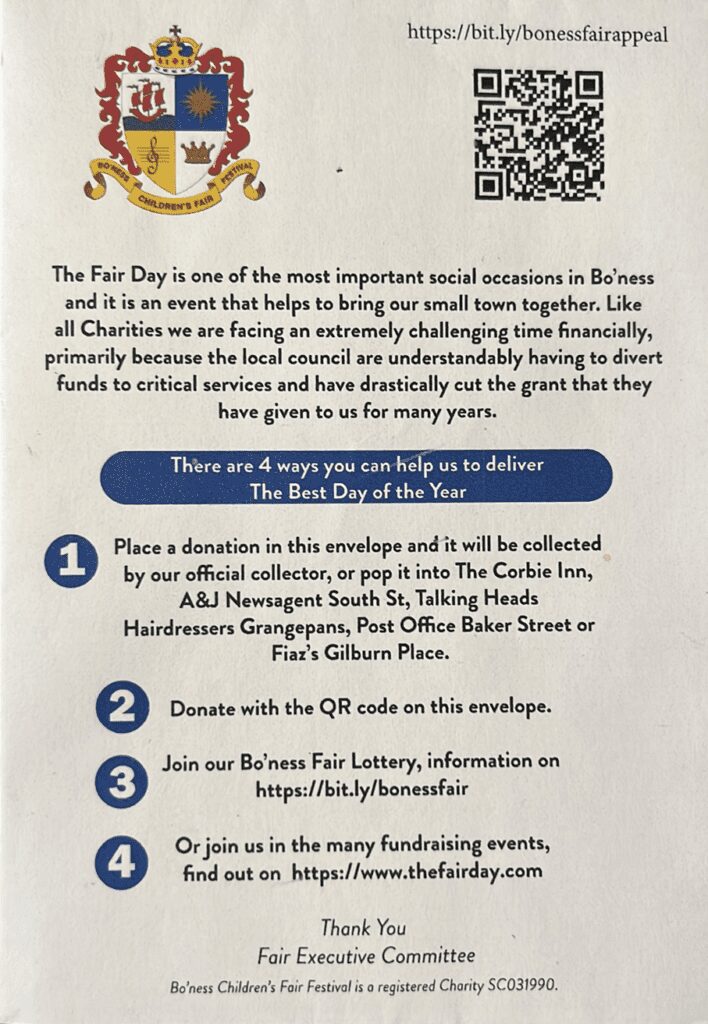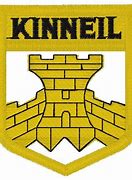As most Bo’nessians will know, the town was once Scotland’s second port ( and reported as such by the 17th century novelist and English spy Daniel Defoe!), Bo’ness had local industries such as coal mining, iron founding, salt panning, whaling, chemicals, potteries and timber which brought prosperity in the 18th and 19th Centuries when there was a great trade with the Baltic ports and the Netherlands. It’s history forms a microcosm of Scotland’s Industrial Revolution and international success. The Bo’ness Fair is an institution which is a major part of the history of the town and is an excellent example of ‘ living heritage ‘.
The aim of the Trust is to bring to life the history of the industry and living conditions of not just Bo’ness but the whole Forth Valley by preserving and displaying buildings, machines etc. by the creation of a 1920s Township on the foreshore site adjacent to the steam railway museum and at other locations in the town and surrounding area. It is recognised by the Inland Revenue as a Charity.
Birkhill Clay Mine
The first attraction to be opened to the public has been the fireclay mine at Birkhill. The main access to the mine is by the Scottish Railway Preservation Society’s steam operated railway from Bo’ness Station, a distance each way of about 3.5 miles. It is felt that the combination of the ride on a traditional steam train and the exciting tour of the underground workings will form a popular attraction for both locals and visitors alike and certainly something well worth taking friends and relatives to when they come back to see the ‘folks at home’ in Bo’ness!
The clay mine is a maze of passageways extending to about 6 miles in total – fireclay was extracted on the ‘ stoop and room ‘ system until the mine was closed in 1980. A CP scheme ( using in part miners from Kinneil Colliery ) has made the mine suitable for public access by clearing the passages on the tour route, putting down gravel paths in the mine and constructing a new cable operated incline railway.
Getting the mine ready for opening has required a lot of support from many organisations ranging from the two local authorities who have supported the Heritage Trust from the outset, national organisations like the Scottish Development Agency and the former Manpower Services Commission to local industry, particularly B.P. which gave some financial support for the project and ICI who have provided much-valued practical assistance by making the installation of underground lighting a project for their two top final year apprentices. They have now installed the new lighting system throughout the mine, which includes festoon lighting in the route to be followed by the public and special effects lighting, such as spotlights, on features of particular interest. Three points have also been installed for supplies to audio- visual equipment.
An unusual opportunity arose to use the mine came late in 1988 when the BBC came to Birkhill to film for a new 3 part documentary on ” The Scottish Miner “. Produced by Billy Kay, the series will show the Miner through history. Birkhill has proved to be an excellent location for filming purposes, since it is classified as a ‘ naked light ‘ mine, which means that no special equipment is necessary to permit filming underground. Broadcasting of the series was scheduled for Spring 1989.
Display boards, 26 in number, are placed along the route both on the surface and underground. Subjects covered include everything from a welcome to the Mine, through the workings of the fireclay milling plant, to aspects of underground working and the Ancient Woodland and Meadow. Some of them incorporate photographs, which introduce both colour and interest. Care has been taken to have those which will be sited on the Incline down to the Mine Mouth in a shade of green, so that they will not intrude visually on the very attractive view of the Avon Gorge, parts of which are classified as a Site of Special Scientific Interest ( SSSI ).
A tableau and AV displays are being produced for use underground. The latter will describe the geology of the mine and the uses of fireclay, and the tableau will have an old miner discussing working in the Clay Mine with a youngster who has just started work.
The 1920s Township
Work started in 1987 at the site of the old timber basin on what will be the biggest and most exciting project for the Trust – the recreation of a Scottish industrial township as it may have appeared in the Forth Valley in the 1920s. It’s street, buildings, closes, wynds and backlands will form an interesting and educational centrepiece, bringing visitors into direct contact with the authentic living conditions of 60 years ago. This work has been made easier by a recent Ground Stabilisation exercise by the Scottish Development Agency to enable buildings to be put up on the site of the timber basin without the use of complicated foundations.
The first building to be completed is ‘ Hamilton’s Cottage ‘ which used to be located near Avon Place and has ‘ taken up its bed and walked ‘; other buildings to follow in the future include a Co-op from Stenhousemuir, a stables and possibly a small cinema.
A key part of the Township Project is to provide a good permanent home for the ‘ Museum of Communication ‘. This began in 1973 and a huge collection of national importance has been accumulated by Trust member Harry Matthews. It has grown in size and scope and now includes thousands of items covering many of the fields of communication – printing, television, telephone, film, computers, radar, wireless, newspapers, gramophone, satellite.
Within the 1920s Township, the aim is to show the development of all these fields and tell a story which touches each and every one of us every minutes of every day – the story of communication.
Creating the Township may take 10 or 15 years and all sorts of help is needed – financial, of course, but also help in kind, donations of artefacts – from a biscuit tin to a whole building are all welcome!
Friends of Bo’ness Heritage
As a first step if you are interested in what the Trust is doing, please do consider joining our support organisation, the ‘ Friends of Bo’ness Heritage’. In addition to having the opportunity to take a direct part in the Trust’s projects, the ‘ Friends ‘ have a social calendar with meetings, film shows and special outings, and also receive both a regular newsletter and news updates on the activities of the Trust. Both locals and ‘ Bo’nessians in exile ‘ are equally welcome and membership costs only £5.00 a year with special rates of £3.00 for the unwaged and £8.00 for families. If you are overseas, an additional contribution to defray postage costs would be greatly appreciated.






